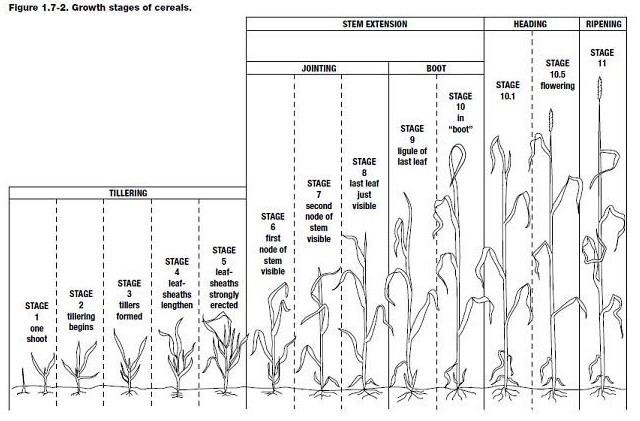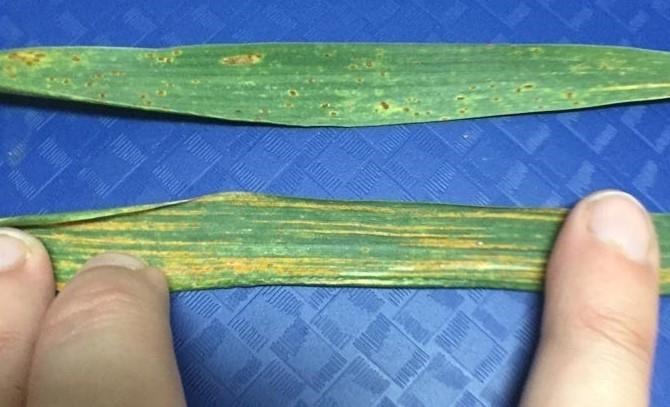By Paul D. Esker and Alyssa Collins
Deciding to apply or not to apply fungicides in your small grain crops should be on your to-do list each growing season. Many production practices like no-till and corn-to-small grain rotations can increase the risk of fungal diseases in our small grains production systems. Nonetheless, before you decide to pull the trigger on spraying a fungicide, in-season integrated management of small grains diseases requires taking into consideration several important components (information adapted from Hershman and Hollier [2008]. Chapter 38 in Plant Pathology Concepts and Laboratory Exercises):
- Know the disease resistance reaction for the small grain variety planted.
- Estimate what your potential crop yield will be.
- You must commit to scouting the field – without this knowledge, you are just guessing if there is a problem rather than managing the disease.
- Know the disease(s) that are important in your production system.
- Quantify the disease intensity.
- Determine the potential number of applications.
- Select the most appropriate fungicide based on your field scouting.
- Understand the risks with different fungicide products.
Once you know the disease reaction (how disease resistant your variety is supposed to be) and the estimated potential yield, it is essential that you are committed to scouting the field. This is not sampling at 65 miles per hour; instead, you need to get into the field and integrate several things like the small grains growth stage, the importance of different leaves, and how they might impact yield. Furthermore, you need to be committed to scouting the entire field and making assessments from different locations. Finally, it is important for each of the major diseases to quantify the disease intensity (i.e., how much disease is present) at each level in the canopy.
Which growth stages do we need to understand?
As we scout early in the spring for wheat diseases , we typically focus on the period from Feekes growth stages 5/6 through flag leaf emergence until flowering (Figure 1). We think of the period at Feekes 5 to Feekes 6 as the stem elongation into the jointing growth stages. At the Feekes 8 to Feekes 9 growth stages, we see the appearance of the last leaf to full flag leaf appearance, which we then follow until flowering, when we focus on decisions related to Fusarium head blight (scab). As you scout the field, it is very important to understand that there is variation with the growth stage across a population (or field) of small grains plants. We focus on identifying the growth stage based on having 50% of the plants at the predominant growth stage. For example, if at least half of the plants in your field are pushing out their flag leaf, we can say this field is "in boot."

Figure 1. Growth stages of cereals (Source: Agronomy Guide, Figure 1.7-2).
What is the importance of different leaves and the head to yield?
The importance of different leaves and the head to final yield vary in terms of importance. In winter wheat, the flag leaf contributes approximately 43% to final yield, while flag-1 (23%) and flag-2 (7%) decrease in relative importance. The head also is important, contributing approximately 22% to final yield. In winter barley, this differs as the leaf sheath contributes approximately 25% to final yield, while the flag leaf only approximately 9%, and flag-1 (20%). The head contributes an additional 13% to final yield. Therefore, the recommendations and thresholds vary across different growth stages (FAR, 2009).
How should we scout for diseases across the field?
There are different approaches that you can use to scout the field, but we often recommend using one of the following patterns: "zig zag", "diamond-shaped", "X-shaped", "W-shaped", or a "modified W shape that adds one additional arm". We recommend assessing 10 different locations in the field and within each location, examining 10 plants selected at random from each sampling location. We look for the presence or absence of the disease (=incidence) and how much of the plant surface area is infected (=severity). You can take notes as you go through the field, which will allow you to estimate the field average then, especially noting the presence of different diseases on different leaves of importance.
Linking your scouting to decision-making
Depending on the small grains disease, the threshold will change as the plant continues to grow. It is important to link your observations with the growth stage. We can summarize some of the available recommendations for wheat as follows for different diseases.
- Powdery mildew: an average of five pustules in the upper leaves. If you are at jointing, focus on the uppermost leaf, but as your crop moves into flag leaf appearance, shift focus to the flag-2 (two leaves below the flag leaf) or flag-1 (one leaf below the flag leaf).
- Septoria leaf blotch: A fungicide application is typically not recommended at earlier growth stages like jointing. As wheat moves into flag leaf emergence, focus on assessing from the flag-2 leaf upward and the threshold is 25% of leaves with blotches.
- Wheat leaf rust: Similar to Septoria leaf blotch, a fungicide is not recommended at the early growth stages like jointing. After that, look for an average of 1 pustule per leaf on any leaf since we know that the disease can increase rapidly under favorable conditions.
Some of the thresholds we can consider for barley include:
- Net blotch: 5% leaf area affected during stem elongation.
- Powdery mildew: 5% of the leaf area on the lowest green leaves.

Picture 2. Leaves showing wheat leaf rust (top) versus wheat strip rust (bottom) (Photo Credit: Alyssa Collins, Penn State)
Linking disease observations to fungicides
Annually, Extension Plant Pathologists across the U.S. collaborate to update the "Fungicide Efficacy for Control of Wheat Diseases." Relative ratings for different wheat diseases are provided for the most widely marketed products. This guide helps to understand how different products can manage these and other important wheat diseases when applied in response to spray thresholds.
Source : psu.edu